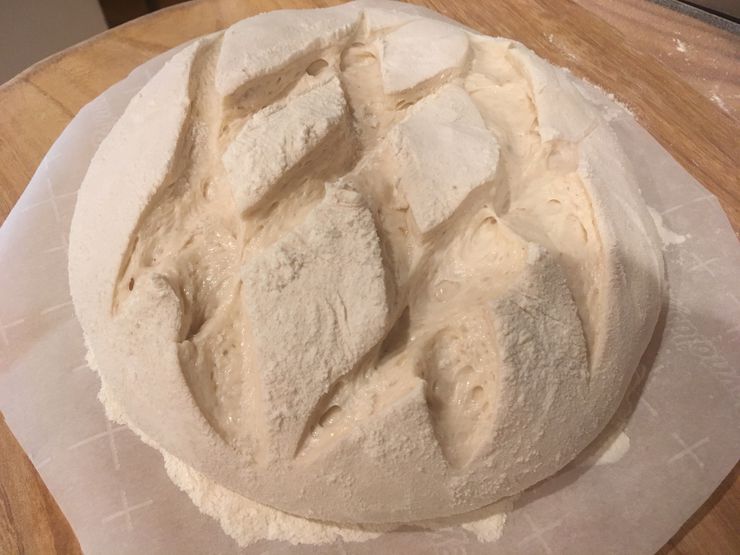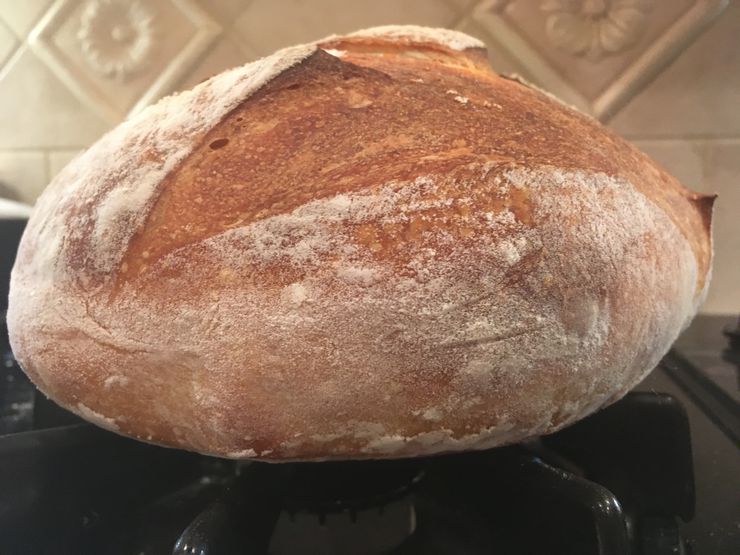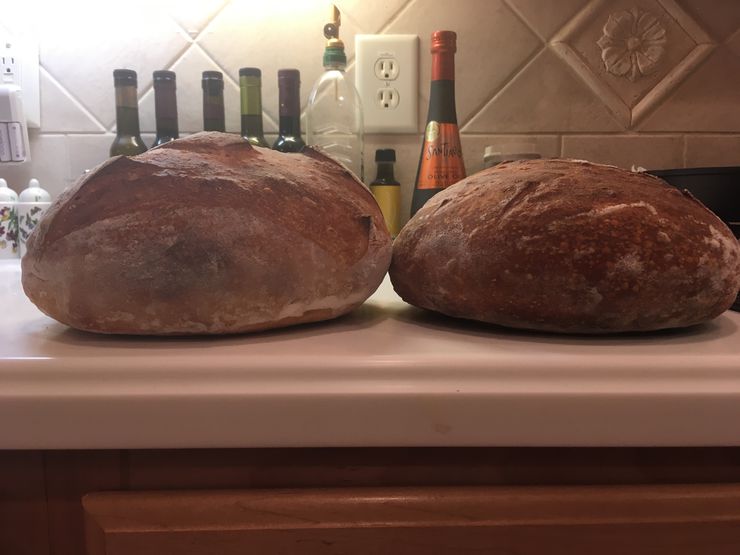2018-11-12
Based on
Influences
https://www.seriouseats.com/2011/06/the-food-lab-the-science-of-no-knead-dough.html
Ingredients
| Ingredient | Weight (grams) | Baker’s Percentage |
|---|---|---|
| King Arthur Bread Flour | 900 | 100.0% |
| Filtered water | 540 | 60.0% |
| Kosher salt | 14 | 1.6% |
| Sourdough Starter * | 600 | 66.7% |
Makes 2 loaves.
* Ischia Island (Italy) sourdough starter at 100% hydration
Total hydration: (540+(600/2))/(900+(600/2)) = 70.0%
Process
Feed starter and allow to ferment in refrigerator for 3 days.
Mix all ingredients and stir with a spoon until combined (but do not knead).
Transfer to a lightly olive-oiled container with top, cover, and allow to rise at room temperature for 18 hours.
Transfer to refrigerator and bulk ferment for 10 hours.
Remove dough from refrigerator and allow it to warm up at room temperature for one hour.
Preheat oven to 410 degrees Fahrenheit with a cast iron skillet on top of a baking stone on the bottom rack.
Flour work surface. Add lots of flour if needed to form a workable dough. Divide dough in two. Shape loaves into rounds, place back in oiled bowls and cover. Proof at 72 degrees for an hour.
Transfer loaves from bowl to parchment paper. Flour the top of the loaves and score with a sharp knife at a 30 degree angle.
Place loaves and parchment paper in hot cast iron skillet, spray with filtered water, place top (an inverted stock pot works well) on skillet, and spray sides of oven with water. Close oven door immediately.
Bake with top on the cast iron skillet for the first 20 minutes, then remove top and spray top of loaf and sides of oven again with filtered water. Close oven door immediately.
When internal temperature reaches 207 degrees Fahrenheit, turn oven temperature to 475 degrees Fahrenheit. Bake for a few minutes longer to brown the crust.
Notes
After 20 minutes in the oven I noticed that the oven had been turned off and was down to about 275 degrees. I immediately turned it back on, but I think some of the oven spring was likely compromised. Still, the oven spring was quite good.
This loaf had notably more sour flavor than other loaves I’ve baked before. I think this is due to fermenting longer at room temperature, but it could also be due to the higher dough hydration.
Salt level was slightly low.
Crust was good.
Crumb was good–had lots of nice big holes, and was not gummy at all. Baking to a higher final temperature seems to make a difference in preventing gumminess.
Oven spring was excellent, especially for the loaf that was baked in the cast iron (see left loaf in “Oven Spring Comparison” image below).
Images






Upcoming experiments
Add more salt.
Try baking in a real cast iron dutch oven.
Consider bulk fermenting at room temperature for 12 hours and up to 2 days in the refrigerator for improved flavor.
Consider making the dough a bit drier for the bulk fermentation stage. Some articles mention that a drier starter makes a more sour bread. Might extend to the bulk fermentation phase as well. This bread was 70.0+% hydration during bulk ferment; maybe try to get below 68% (or lower) and see how it goes.
Consider using a banneton without liner for improved shape.
Consider turning on convection bake (and turning oven temp to 450 degrees Fahrenheit) earlier.
Consider letting the bread bake to a hotter internal temp (208-209 degrees Fahrenheit) to make the crumb a little drier/less tough/fluffier.